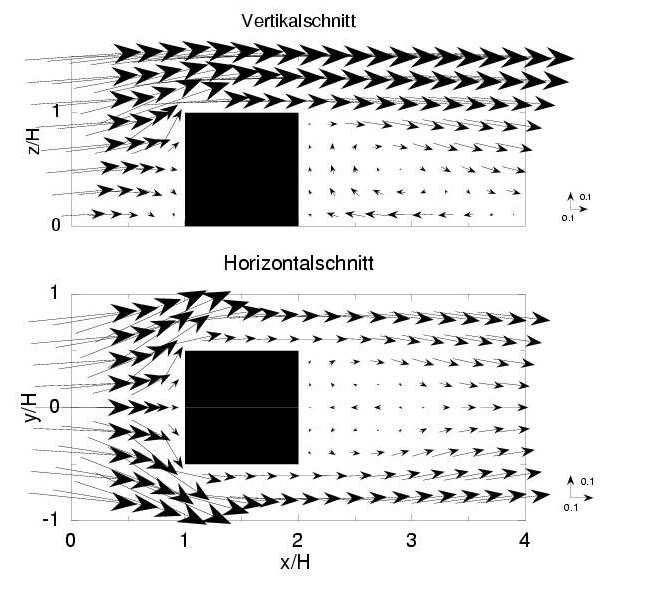
Fig: Example of the flow around a cube, horizontal and vertical
cross-section through cube center.
Numerical modelling of turbulent flow around buildings

Fig: Example of the flow around a cube, horizontal and vertical
cross-section through cube center.
Dissertation in pdf in german here.
To the list of all publications.
Abstract:
With the microscale model MITRAS we study the influence of different turbulence closures on the flow field around different obstacles. The purpose is to find a turbulence closure adapted to the relatively coarse model grids used. The following turbulence closure types have been used: the Smagorinsky closure, the energy-mixing-length closure and the energy-dissipation closure. All closures are implemented in an one- and three dimensional model version. Results of model simulation are compared with field and wind channel measurements.
Independently of the used closure the essential characteristics of the flow field around an obstacle, like the eddy on its downstream side, are qualitatively consistent with the measurements. Characteristic eddies on top and in front of buildings can be modeled with a higher grid resolution.
The details of the velocity fields, the turbulent momentum fluxes and the turbulent kinetic energy show great differences depending on the parametrization of the momentum fluxes. Open parameters of the closures are recalculated for the relatively coarse grid used in the present work. The best parameters of the energy-dissipation-closure are independent of the obstacle type and correspond to those given by Launder et al. (1972).
Simulations carried out with the energy-dissipation-closure produce at the upstream side of obstacles values of momentum fluxes and of the turbulent kinetic energy much higher then the measurements. With modified versions of the energy-dissipation-closure these unrealistic high values could be avoided.
A comparison of numerical simulations with wind channel measurements show that the best agreement between model results and observations is obtained with a modified closure of Kato und Launder (1993). This closure was used finally to model the flow field in a urban area.